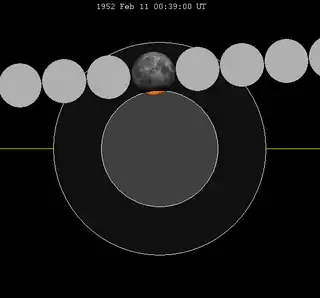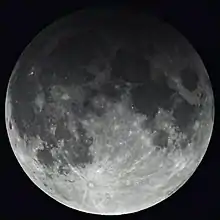July 1953 lunar eclipse
A total lunar eclipse took place on Sunday, July 26, 1953.
| Total Lunar Eclipse July 26, 1953 | |
|---|---|
| (No photo) | |
 The moon passes west to east (right to left) across the Earth's umbral shadow, shown in hourly intervals. | |
| Series | 128 (37 of 71) |
| Gamma | -0.0071 |
| Magnitude | 1.8628 |
| Duration (hr:mn:sc) | |
| Totality | 1:40:42 |
| Partial | 3:35:42 |
| Penumbral | 5:26:30 |
| Contacts (UTC) | |
| P1 | 9:37:55 |
| U1 | 10:33:19 |
| U2 | 11:30:49 |
| Greatest | 12:21:10 |
| U3 | 13:11:31 |
| U4 | 14:09:01 |
| P4 | 15:04:25 |
The Moon passed through the very center of the Earth's shadow. While the visual effect of a total lunar eclipse is variable, the Moon may have been stained a deep orange or red colour at maximum eclipse. This was a great spectacle for everyone who saw it from Australia as well as parts of Asia, Korea, New Zealand and Hawaii. The partial lunar eclipse lasted for 3 hours and 35 minutes 42 seconds in total. With an umbral lunar eclipse magnitude of 1.8628, this was the largest lunar eclipse of the 20th century. Gamma had a value of only -0.0071. Due to the Moon's relatively large size, totality lasted 100 minutes 42 seconds unlike July 16, 2000 which lasted 106 minutes 25 seconds, the longest since August 13, 1859 (which was only 3 seconds longer). This was the darkest total lunar eclipse in the 20th century.
Visibility
It can all be seen from Australia, is seen rising in East Asia and is seen in North and South America. It is also visible from Korea as well as New Zealand and Hawaii, including Vietnam

Related lunar eclipses
Lunar year series
| Descending node | Ascending node | |||||
|---|---|---|---|---|---|---|
| Saros | Date Viewing |
Type Chart |
Saros | Date Viewing |
Type Chart | |
| 103 | 1951 Feb 21 |
Penumbral |
108 | 1951 Aug 17 |
Penumbral | |
| 113 | 1952 Feb 11 |
Partial |
118 | 1952 Aug 5 |
Partial | |
| 123 | 1953 Jan 29 |
Total |
128 | 1953 Jul 26 |
Total | |
| 133 | 1954 Jan 19 |
Total |
138 | 1954 Jul 16 |
Partial | |
| 143 | 1955 Jan 8 |
Penumbral | ||||
| Last set | 1951 Mar 23 | Last set | 1951 Sep 15 | |||
| Next set | 1955 Nov 29 | Next set | 1955 Jun 5 | |||
Saros series
Lunar saros series 128, repeating every 18 years and 11 days, has a total of 71 lunar eclipse events including 57 umbral eclipses (42 partial lunar eclipses and 15 total lunar eclipses). Solar Saros 135 interleaves with this lunar saros with an event occurring every 9 years 5 days alternating between each saros series.
| Greatest | First | |||
|---|---|---|---|---|
 The greatest eclipse of the series occurred on 1953 Jul 26, lasting 108 minutes.[1] |
Penumbral | Partial | Total | Central |
| 1304 Jun 18 | 1430 Sep 2 | 1845 May 21 | 1899 Jun 23 | |
| Last | ||||
| Central | Total | Partial | Penumbral | |
| 2007 Aug 28 | 2097 May 21 | 2440 May 17 | 2566 Aug 2 | |
| 1917 Jul 4 | 1935 Jul 16 | 1953 Jul 26 | |||
 |
 |
 |
 |
 |
 |
| 1971 Aug 6 | 1989 Aug 17 | 2007 Aug 28 | |||
 |
 |
 |
 |
 |
 |
| 2025 Sep 7 | 2043 Sep 19 | 2061 Sep 29 | |||
 |
 |
 |
 |
 |
 |
| 2079 Oct 10 | 2097 Oct 21 | ||||
 |
 |
 |
 | ||
Lunar Saros 128 contains 15 total lunar eclipses between 1845 and 2097 (in years 1845, 1863, 1881, 1899, 1917, 1935, 1953, 1971, 1989, 2007, 2025, 2043, 2061, 2079 and 2097). Solar Saros 135 interleaves with this lunar saros with an event occurring every 9 years 5 days alternating between each saros series.
Inex series
The inex series repeats eclipses 20 days short of 29 years, repeating on average every 10571.95 days. This period is equal to 358 lunations (synodic months) and 388.5 draconic months. Saros series increment by one on successive Inex events and repeat at alternate ascending and descending lunar nodes.
This period is 383.6734 anomalistic months (the period of the Moon's elliptical orbital precession). Despite the average 0.05 time-of-day shift between subsequent events, the variation of the Moon in its elliptical orbit at each event causes the actual eclipse time to vary significantly. It is a part of Lunar Inex series 39.
All events in this series listed below and more are total lunar eclipses.
| Ascending node | Descending node | Ascending node | Descending node | ||||
|---|---|---|---|---|---|---|---|
| Saros | Date | Saros | Date | Saros | Date | Saros | Date |
| 96 | 1027 Apr 23 | 97 | 1056 Apr 2 | 98 | 1085 Mar 14 | 99 | 1114 Feb 21 |
| 100 | 1143 Feb 1 | 101 | 1172 Jan 13 | 102 | 1200 Dec 22 | 103 | 1229 Dec 2 |
| 104 | 1258 Nov 12 | 105 | 1287 Oct 22 | 106 | 1316 Oct 2 | 107 | 1345 Sep 12 |
| 108 | 1374 Aug 22 | 109 | 1403 Aug 2 | 110 | 1432 Jul 13 | 111 | 1461 Jun 22 |
| 112 | 1490 Jun 2 | 113 | 1519 May 14 | 114 | 1548 Apr 22 | 115 | 1577 Apr 2 |
| 116 | 1606 Mar 24 | 117 | 1635 Mar 3 | 118 | 1664 Feb 11 | 119 | 1693 Jan 22 |
| 120 | 1722 Jan 2 | 121 | 1750 Dec 13 | 122 | 1779 Nov 23 | 123 | 1808 Nov 3 |
| 124 | 1837 Oct 13 | 125 | 1866 Sep 24 | 126 | 1895 Sep 4 | 127 | 1924 Aug 14 |
| 128 | 1953 Jul 26 |
129 | 1982 Jul 6 |
130 | 2011 Jun 15 |
131 | 2040 May 26 |
| 132 | 2069 May 6 |
133 | 2098 Apr 15 |
134 | 2127 Mar 28 | 135 | 2156 Mar 7 |
| 136 | 2185 Feb 14 | 137 | 2214 Jan 27 | 138 | 2243 Jan 7 | 139 | 2271 Dec 17 |
| 140 | 2300 Nov 27 | 141 | 2329 Nov 7 | 142 | 2358 Oct 18 | 143 | 2387 Sep 28 |
| 144 | 2416 Sep 7 | 145 | 2445 Aug 17 | 146 | 2474 Jul 29 | ||
Half-Saros cycle
A lunar eclipse will be preceded and followed by solar eclipses by 9 years and 5.5 days (a half saros).[2] This lunar eclipse is related to two annular solar eclipses of Solar Saros 135.
| July 20, 1944 | July 31, 1962 |
|---|---|
 |
 |
Notes
- Listing of Eclipses of cycle 128
- Mathematical Astronomy Morsels, Jean Meeus, p.110, Chapter 18, The half-saros
External links
References
- Bao-Lin Liu, Canon of Lunar Eclipses 1500 B.C.-A.D. 3000, 1992

_(cropped).jpg.webp)
